

Bell Rock Lighthouse. Robert Stevenson (civil engineer) One of his finest achievements was the construction of the Bell Rock Lighthouse.
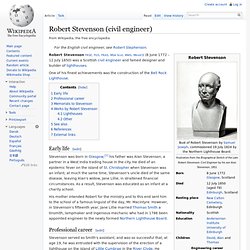
Stevenson was born in Glasgow;[1] his father was Alan Stevenson, a partner in a West India trading house in the city. He died of an epidemic fever on the island of St. Christopher when Stevenson was an infant; at much the same time, Stevenson's uncle died of the same disease, leaving Alan's widow, Jane Lillie, in straitened financial circumstances. As a result, Stevenson was educated as an infant at a charity school. Stevenson served as Smith's assistant, and was so successful that, at age 19, he was entrusted with the supervision of the erection of a lighthouse on the island of Little Cumbrae in the River Clyde.
In 1797 he was appointed engineer to the Lighthouse Board in succession to Smith; in 1799 he married Smith's eldest daughter Jean, who was also his stepsister, and in 1800 was adopted as Smith's business partner. He was made a Fellow of the Royal Society in 1815. Richard Henry Brunton Attribution. Overview of Robert Stevenson. Stevenson, Robert genealogy family history Scotland. Robert Stevenson. Robert Stevenson was born on the 8th of June, 1772.
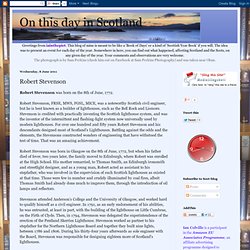
Robert Stevenson, FRSE, MWS, FGSL, MICE, was a noteworthy Scottish civil engineer, but he is best known as a builder of lighthouses, such as the Bell Rock and Lismore. Stevenson is credited with practically inventing the Scottish lighthouse system, and was the inventor of the intermittent and flashing-light system now universally used by modern lighthouses. For over one hundred and fifty years Robert Stevenson and his descendants designed most of Scotland’s Lighthouses. Robert Stevenson 1772-1850 : Scotland Magazine Issue 55. Born in Glasgow on 8 June 1772, Robert Stevenson was the only son of Alan Stevenson, a West Indies merchant.
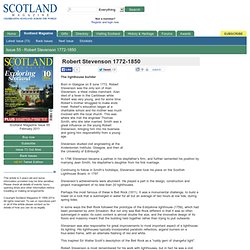
Alan died of a fever in the Caribbean while Robert was very young, and for some time Robert’s mother struggled to make ends meet. Robert’s education began at a charitable school and his mother was much involved with the local church. This was where she met the engineer Thomas Smith, who she later married. Smith was a great influence on the young Robert Stevenson, bringing him into his business and giving him responsibility from a young age. Stevenson studied civil engineering at the Andersonian Institute, Glasgow, and then at the University of Edinburgh. In 1796 Stevenson became a partner in his stepfather’s firm, and further cemented his position by marrying Jean Smith, his stepfather’s daughter from his first marriage.
Northern Lighthouse Board - Robert Stevenson. Northern Lighthouse Board - Stevenson Engineers. The Sensational Stevensons For over one hundred and fifty years Robert Stevenson and his descendants designed most of Scotland's Lighthouses.
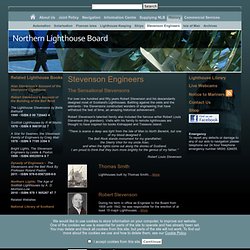
Battling against the odds and the elements - the Stevensons constructed wonders of engineering that have withstood the test of time, an amazing historical achievement. Robert Stevenson's talented family also included the famous writer Robert Louis Stevenson (his grandson). Visits with his family to remote lighthouses are thought to have inspired his books Kidnapped and Treasure Island. "There is scarce a deep sea light from the Isle of Man to North Berwick, but one of my blood designed it. Robert Stevenson. 1810.
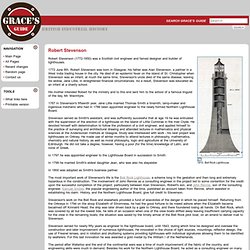
Bell Rock Lighthouse. Robert Stevenson (1772-1850) was a Scottish civil engineer and famed designer and builder of lighthouses. 1772 June 8th. Bellrock.org.uk : Stevensons : Robert Stevenson 1772-1850. Robert Stevenson. Biographical Sketch of the Late Robert Stevenson: Civil Engineer - Alan Stevenson. Life of Robert Stevenson, civil engineer.. : Stevenson, David, 1815-1886.
Records of a Family of Engineers by Robert Louis Stevenson. Stevenson's Bell Rock Light-House : Robert Stevenson. History of the Stevenson / Stephenson / Stephen Clan. Bell Rock Lighthouse. The masonry work on which the lighthouse rests was constructed to such a high standard that it has not been replaced or adapted in 200 years.[3] The lamps and reflectors were replaced in 1843 and used in the lighthouse at Cape Bonavista, Newfoundland, where they are currently on display.[4] The working of the lighthouse has been automated since 1988.[1] The lighthouse operated in tandem with a shore station, the Bell Rock Signal Tower, built in 1813 at the mouth of Arbroath harbour. Today this building houses the Signal Tower Museum, a visitor centre detailing the history of the lighthouse. The challenges faced in the building of the lighthouse have led to it being described as one of the Seven Wonders of the Industrial World.
History[edit] According to legend, the rock is called Bell Rock because of a 14th-century attempt by the Abbot of Arbroath to install a warning bell on it. Construction[edit] During the spring of 1808, work resumed. Loss of HMS Argyll[edit] HMS Argyll In culture[edit]